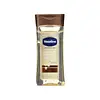What's inside
What's inside
 Key Ingredients
Key Ingredients

No key ingredients
 Benefits
Benefits

No benefits
 Concerns
Concerns

 Ingredients Side-by-side
Ingredients Side-by-side

Water
Skin ConditioningGlycerin
HumectantPetrolatum
EmollientStearic Acid
CleansingCaprylic/Capric Triglyceride
MaskingButylene Glycol
HumectantGlycol Stearate
EmollientPEG-100 Stearate
Dimethicone
EmollientGlyceryl Stearate
EmollientCetyl Alcohol
EmollientPhenoxyethanol
PreservativeMagnesium Aluminum Silicate
AbsorbentParfum
MaskingMethylparaben
PreservativeXanthan Gum
EmulsifyingHydroxyethylcellulose
Emulsion StabilisingPropylparaben
PreservativeXanthophylls
Skin ConditioningPotassium Hydroxide
BufferingStearamide Amp
Disodium EDTA
Argania Spinosa Kernel Oil
EmollientTocopheryl Acetate
AntioxidantHelianthus Annuus Seed Oil
EmollientHydroxystearic Acid
CleansingSodium Nitrate
SoothingPotassium Carbonate
BufferingPolysorbate 60
EmulsifyingDisodium Phosphate
BufferingSodium Phosphate
BufferingPalmitic Acid
EmollientArachidic Acid
CleansingCitric Acid
BufferingAlpha-Isomethyl Ionone
PerfumingCoumarin
PerfumingLinalool
PerfumingWater, Glycerin, Petrolatum, Stearic Acid, Caprylic/Capric Triglyceride, Butylene Glycol, Glycol Stearate, PEG-100 Stearate, Dimethicone, Glyceryl Stearate, Cetyl Alcohol, Phenoxyethanol, Magnesium Aluminum Silicate, Parfum, Methylparaben, Xanthan Gum, Hydroxyethylcellulose, Propylparaben, Xanthophylls, Potassium Hydroxide, Stearamide Amp, Disodium EDTA, Argania Spinosa Kernel Oil, Tocopheryl Acetate, Helianthus Annuus Seed Oil, Hydroxystearic Acid, Sodium Nitrate, Potassium Carbonate, Polysorbate 60, Disodium Phosphate, Sodium Phosphate, Palmitic Acid, Arachidic Acid, Citric Acid, Alpha-Isomethyl Ionone, Coumarin, Linalool
 Reviews
Reviews

Ingredients Explained
These ingredients are found in both products.
Ingredients higher up in an ingredient list are typically present in a larger amount.
Coumarins are a group of substances found naturally in plants. There are over 1300 types of coumarins identified. It has a natural vanilla scent.
Coumarin is an identified EU known allergy, meaning it may cause an allergic reaction when applied to the skin.
In many countries, coumarin is banned as a food additive. However, it can be found in soaps, tobacco products, and some alcohol drinks.
Plants use coumarins as a chemical defense. Some plants that have coumarins include lavender, tonka beans, and yellow clovers.
Learn more about CoumarinLinalool is a fragrance and helps add scent to products. It's derived from common plants such as cinnamon, mint, citrus, and lavender.
Like Limonene, this ingredient oxidizes when exposed to air. Oxidized linalool can cause allergies and skin sensitivity.
This ingredient has a scent that is floral, spicy tropical, and citrus-like.
Learn more about LinaloolParfum is a catch-all term for an ingredient or more that is used to give a scent to products.
Also called "fragrance", this ingredient can be a blend of hundreds of chemicals or plant oils. This means every product with "fragrance" or "parfum" in the ingredients list is a different mixture.
For instance, Habanolide is a proprietary trade name for a specific aroma chemical. When used as a fragrance ingredient in cosmetics, most aroma chemicals fall under the broad labeling category of “FRAGRANCE” or “PARFUM” according to EU and US regulations.
The term 'parfum' or 'fragrance' is not regulated in many countries. In many cases, it is up to the brand to define this term.
For instance, many brands choose to label themselves as "fragrance-free" because they are not using synthetic fragrances. However, their products may still contain ingredients such as essential oils that are considered a fragrance by INCI standards.
One example is Calendula flower extract. Calendula is an essential oil that still imparts a scent or 'fragrance'.
Depending on the blend, the ingredients in the mixture can cause allergies and sensitivities on the skin. Some ingredients that are known EU allergens include linalool and citronellol.
Parfum can also be used to mask or cover an unpleasant scent.
The bottom line is: not all fragrances/parfum/ingredients are created equally. If you are worried about fragrances, we recommend taking a closer look at an ingredient. And of course, we always recommend speaking with a professional.
Learn more about Parfum